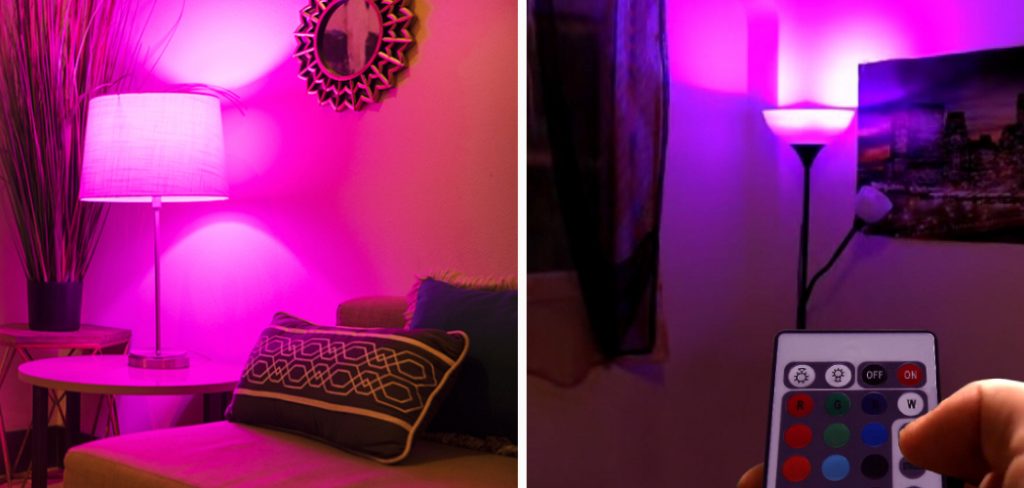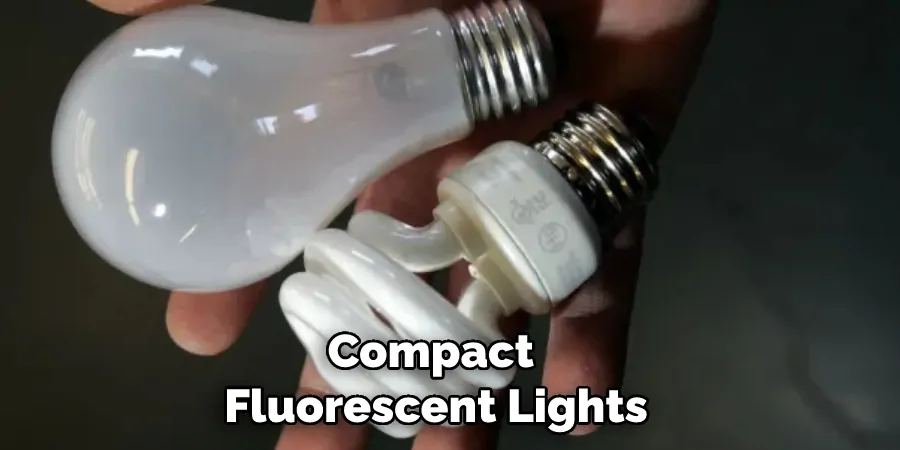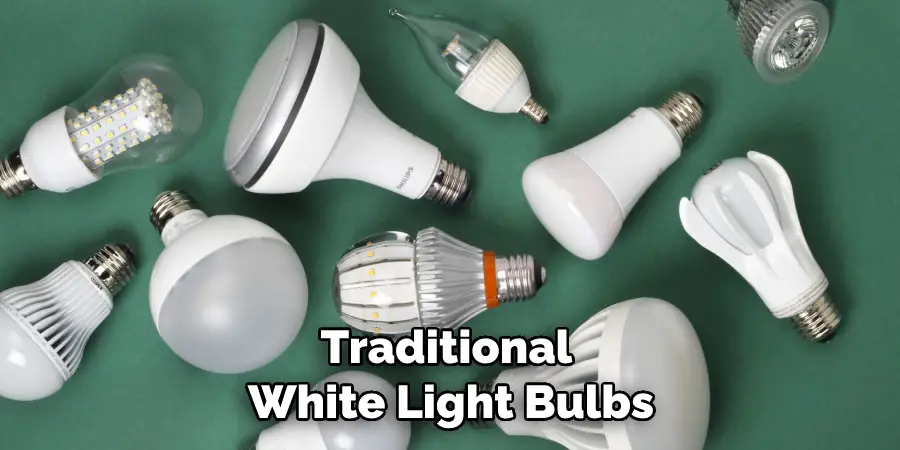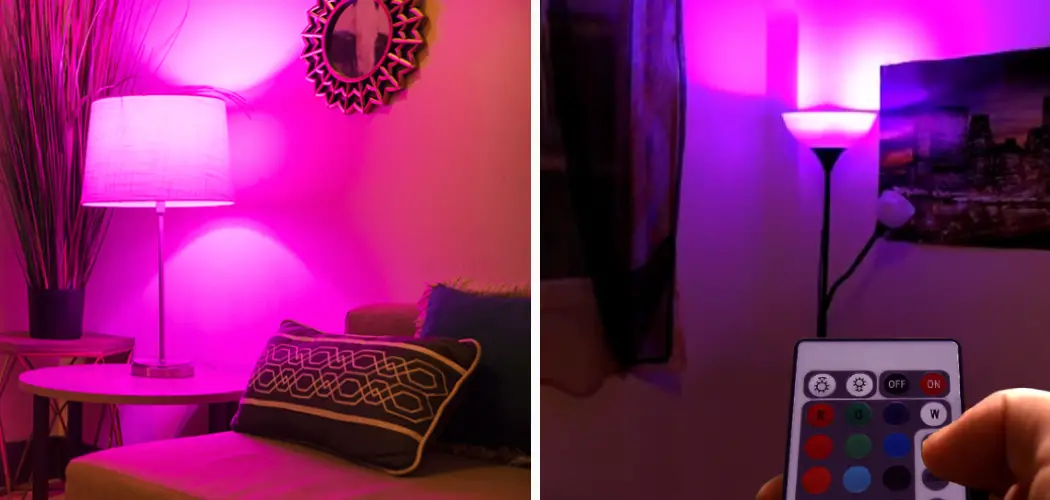There are many reasons why changing the color of a light bulb can be beneficial. First, it can create different moods and ambiance in your home or workspace. For example, warm white light bulbs emit a gentle yellow-white glow that is ideal for creating a cozy atmosphere. On the other hand, cool white light bulbs emit a crisp blue-white light that is perfect for productivity and focus.

The primary advantage of being able to change the color of a light bulb is its versatility. Homeowners can easily match their interior design needs by changing the hue of their bulbs. This also makes it easier for people who use different colors in different rooms or areas, such as red lighting in a bedroom and blue lighting in an office. Additionally, changing the light bulb color can create a unique atmosphere. In this blog post, You will learn in detail how to change color of light bulb.
Step by Step Processes for How to Change Color of Light Bulb
Step 1: Inspect the Bulb
Before attempting to change the color of a light bulb, make sure the bulb is suitable for color changing. Check the wattage and voltage to ensure it meets the color-changing bulb requirements.
Step 2: Determine Which Type of Bulb You Need
There are two types of bulbs that can be used to change color lighting–incandescent bulbs and LED bulbs. Incandescent bulbs are cheaper, but the color change is limited to a few shades of white. LEDs are more expensive and offer a wider range of colors.

Step 3: Choose Your Color
Consider what type of effect you want to achieve before selecting a color for your bulb. There are many colors available, including shades of white, yellow, red, and blue. Buy the correct bulb for your needs. Ensure the wattage and voltage match those the manufacturer specified before purchasing.
Step 4: Install the Bulb
Follow any instructions included with the bulb. Generally, you’ll need to screw the bulb into a lamp or ceiling light fixture. Ensure the power source is compatible and the voltage matches the bulb’s requirements before connecting it.
Step 5: Set Up Your Color-Changing Device
If your bulb is connected to a controller or remote, follow the manufacturer’s instructions for setting it up. Some controllers use an app, while others may require buttons on the device itself. Depending on your device, select the color you want by tapping an app option or pressing buttons on the controller.
After you choose a color, the light bulb should change to that hue. Enjoy the new lighting effect. Depending on your device, you can switch between colors as often as you’d like. Have fun experimenting with different hues and tones. Follow these steps to quickly and easily change the color of a light bulb. With a few simple tools, you can enjoy colorful lighting in any room of your home.
Safety Precautions for How to Change Color of Light Bulb

- Unplug your light fixture before proceeding with the bulb change, or turn off power to the circuit at your breaker box.
- Place a cloth or rag over the switch plate to help protect against any broken pieces of glass if something goes awry when you remove the bulb.
- Carefully remove the bulb from the socket, using a firm grip and being cautious not to allow any moisture or abrasive material to come in contact with it.
- Make sure to check the wattage of your new bulb before installing it; bulbs rated for higher wattages can cause fires if installed in sockets not designed for them.
- Wear gloves. Make sure to wear rubber gloves or otherwise insulated handwear when handling bulbs, as the oils in your skin can significantly reduce the lifespan of some light bulbs.
- Use a ladder if you can’t reach the bulb. It’s better to be safe than sorry, so make sure you use a step ladder or other safe methods to reach your light bulb.
- Know how to dispose of used bulbs properly. Dispose of fluorescent and LED bulbs carefully, as they contain mercury or lead that can be toxic if damaged or disposed of illegally.
- Wipe down any dust or fingerprints on the new bulb with a soft cloth before placing it into the socket. This will help preserve the bulb’s clarity and prevent dust from decreasing output over time.

Changing a light bulb’s color is a fairly straightforward process, but following these safety precautions ensures that you can do it safely and effectively.
How Long Will a Colored Light Bulb Last?
When it comes to changing the color of a light bulb, an important factor to consider is how long the colored bulb will last. LEDs normally have a much longer lifespan than incandescent bulbs – up to 50 times as long. That means you can enjoy the same vibrant colors for years without worrying about replacing your bulbs frequently. On the other hand, incandescent bulbs usually only last for a few months before needing to be changed. Depending on how often you use your colored light bulb, it may be well worth investing in LED technology, so you don’t have to replace them as often.
On top of long-lasting capabilities, LEDs consume less power and can provide more illumination than traditional incandescent bulbs. LEDs are also more durable and resistant to vibrations, shocks, and moisture – making them perfect for outdoor lighting applications. When it comes to the longevity of colored light bulbs, LEDs are typically the best option. With their longer lifespan, efficient energy use, and overall durability, they are a great choice for those looking to add some color without having to worry about frequent replacement.
How Much Will It Cost to Replace a Colored Light Bulb?
When it comes to replacing color light bulbs, the cost will depend on a number of factors. First, you’ll need to consider what bulb you want to replace. The most common types of colored bulbs include CFLs (compact fluorescent lights), halogens, and LEDs (light-emitting diodes). Each of these types has pros and cons, so you’ll need to determine which will best fit your needs.

In terms of cost, CFLs are usually the most inexpensive option, followed by halogens and then LEDs. How much a bulb costs also depends on its wattage, brightness level, and other features. For instance, high-performance LED bulbs tend to be more expensive than standard models. You should also factor in the cost of installation when replacing a colored light bulb. Depending on your setup and how you plan to install it, the total costs could rise significantly – so make sure to consider this beforehand.
How Often Should You Change Out the Colored Light Bulbs?
The frequency of changing out colored light bulbs will depend on the type of bulb you are using. Incandescent bulbs, which are often used for specialty lighting and decorations, should be changed every year or two. Fluorescent and LED bulbs tend to last longer due to their energy efficiency but should be checked regularly for flickering or discoloration. Depending on where you’re using colored light bulbs, replacing them with new ones annually may be a good idea for safety purposes.
Additionally, if the bulb is used outside and exposed to extreme weather conditions such as snow or rain, it should be replaced more frequently. In short, for incandescent lights, change out the colored bulbs every year or two. Regularly check for flickering or discoloration for fluorescent and LED lights and replace them as needed. If used outdoors in extreme weather conditions, consider replacing the bulbs annually for safety purposes.
How Do You Clean the Colored Light Bulb After Installation?
After installing a colored light bulb, it is important to clean the bulb before use. This will help ensure that the desired color shines through when illuminated. To start, switch the light off and unscrew the old bulb from the socket. Once removed, carefully wipe away any dust or debris with a soft cloth dampened in soapy water.

from the socket. Once removed, carefully wipe away any dust or debris with a soft cloth dampened in soapy water.
If the bulb is particularly dirty, you may need to use a cotton swab and some rubbing alcohol. Be sure not to touch any part of the glass or filament of the bulb with your bare hands, as this could cause damage or discoloration. Once dry, carefully replace the bulb in its socket and switch it on to enjoy your new color of light.
By following the above steps, you can successfully and safely change the color of your light bulb without damaging it in any way.
How Can You Find Out More Information About How to Change Color of Light Bulb?
Many resources are available to help you learn more about Changing the Color of a Light Bulb. You can start by searching online for tips, tutorials, and step-by-step instructions on how to change the color of your light bulb. Additionally, you may be able to find information from local hardware stores or other home improvement centers. They may offer advice on the specific type of bulb and tools you need to change the color of your light bulb.
You can also consult an electrician or home improvement professional for help with Changing the Color of the Light Bulb. Electrical wiring is a complicated process, and it’s important to ensure that any modifications you make to your light bulb do not create a safety hazard. An experienced professional can provide you with the right information and guidance to help you change the color of your light bulb safely and effectively.
Are There Any Risks Associated With Using Colored Light Bulbs?
Yes, there are some risks associated with using colored light bulbs. Since these bulbs emit a different color of light than regular white bulbs, they can create glare or be too bright for certain situations. Furthermore, the colors might not match your décor as expected. Additionally, these bulbs may not last as long as traditional white light bulbs. If you are considering using colored light bulbs, research the safety requirements and check with your local health department.

Additionally, ensure the light fixture is equipped to handle the wattage of these bulbs. Finally, be aware that different colors of light may affect people in different ways. Depending on your individual situation and preferences, it may be best to stick with traditional white light bulbs.
Overall, while colored light bulbs can be a fun and unique way to change the look of your space, it is important to understand the risks associated with using them. By doing your research and understanding how these bulbs may affect you and your environment, you can make an informed decision about whether colored light bulbs are right for you.
How Can You Ensure That Your Colored Light Bulbs Are Energy Efficient?
When changing the color of your light bulbs, it is important to ensure that you are still using energy-efficient options. LED and CFL bulbs are considered the most energy-efficient options as they use less electricity to produce more light. If you decide to go with an incandescent bulb for your colored lighting needs, make sure you choose one that is certified by ENERGY STAR. It will consume up to 30% less energy than a standard incandescent bulb, resulting in lower electricity bills. Additionally, you may want to opt for dimmable bulbs if you plan on adjusting the brightness of your lights.
When shopping for colored light bulbs, check the lumens (brightness) rating, wattage, and color temperature on the packaging to ensure you get a bulb that produces the desired effect. Also, look for bulbs with long life spans, as this will save you money in replacement costs over time.
Finally, remember that colored light bulbs come in a range of shapes and sizes—from globe-shaped bulbs to small spotlights. Take time to select a bulb that will provide the best illumination for your space. With careful consideration and proper installation, your colored light bulbs can last a long time while saving you energy and money.
Conclusion
One of the main disadvantages of changing the color of a light bulb is that it can be expensive. Depending on what type of bulb you are using, there may be an additional cost for buying different colored bulbs. Additionally, if you are looking to change the color regularly, this can lead to a lot more expensive over time as well.
In conclusion, changing the color of a light bulb is relatively straightforward and can be done with minimal effort. Generally, you will need to purchase a colored light bulb that fits the same base size as your existing one. After unscrewing the old one, screw in the new bulb and tighten it securely.
With these tips, you can easily change the color of your light bulb and create the perfect atmosphere for any room without having to replace your lighting fixtures completely. I hope this article has been beneficial for learning how to change color of light bulb. Make Sure the precautionary measures are followed chronologically.

